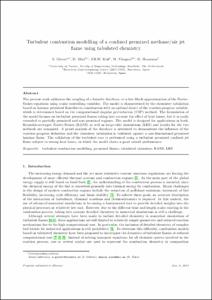Mostra el registre d'ítem simple
Turbulent combustion modelling of a confined premixed jet flame including heat loss effects using tabulated chemistry
| dc.contributor.author | Gövert, Simon |
| dc.contributor.author | Mira Martínez, Daniel |
| dc.contributor.author | Kok, Jim B. W. |
| dc.contributor.author | Vázquez, Mariano |
| dc.contributor.author | Houzeaux, Guillaume |
| dc.contributor.other | Barcelona Supercomputing Center |
| dc.date.accessioned | 2016-03-15T14:35:05Z |
| dc.date.available | 2017-10-17T00:30:27Z |
| dc.date.issued | 2015-10-15 |
| dc.identifier.citation | Gövert, Simon [et al.]. Turbulent combustion modelling of a confined premixed jet flame including heat loss effects using tabulated chemistry. "Applied Energy", 15 Octubre 2015, vol. 156, p. 804-815. |
| dc.identifier.issn | 0306-2619 |
| dc.identifier.uri | http://hdl.handle.net/2117/84404 |
| dc.description.abstract | The present work addresses the coupling of a flamelet database, to a low-Mach approximation of the Navier–Stokes equations using scalar controlling variables. The model is characterized by the chemistry tabulation based on laminar premixed flamelets in combination with an optimal choice of the reaction progress variable, which is determined based on the computational singular perturbation (CSP) method. The formulation of the model focuses on turbulent premixed flames taking into account the effect of heat losses, but it is easily extended to partially premixed and non-premixed regimes. The model is designed for applications in both, Reynolds-averaged Navier–Stokes (RANS) as well as large-eddy simulations (LES) and results for the two methods are compared. A priori analysis of the database is presented to demonstrate the influence of the reaction progress definition and the chemistry tabulation is validated against a one-dimensional premixed laminar flame. The validation of the turbulent case is performed using a tur- bulent premixed confined jet flame subject to strong heat losses, in which the model shows a good overall performance. |
| dc.description.sponsorship | The research leading to these results has received funding through the People Programme (Marie Curie Actions) of the European Union’s Seventh Framework Programme (FP7, 2007– 2013) under the grant agreement No. FP7-290042 for the project COPA-GT. The authors thankfully acknowledge the computer resources, technical expertise and assistance provided by the Red Española de Supercomputación (RES). Finally, the authors would like to thank O. Lammel for kindly providing the data for comparison. |
| dc.format.extent | 12 p. |
| dc.language.iso | eng |
| dc.publisher | Elsevier |
| dc.rights | Attribution-NonCommercial-NoDerivs 4.0 International License |
| dc.rights.uri | https://creativecommons.org/licenses/by-nc-nd/4.0/ |
| dc.subject | Àrees temàtiques de la UPC::Enginyeria electrònica |
| dc.subject.lcsh | Combustion--Research |
| dc.subject.other | Turbulent combustion modelling |
| dc.subject.other | Premixed ames |
| dc.subject.other | Tabulated chemistry |
| dc.subject.other | RANS |
| dc.subject.other | LES |
| dc.title | Turbulent combustion modelling of a confined premixed jet flame including heat loss effects using tabulated chemistry |
| dc.type | Article |
| dc.subject.lemac | Combustió--Models matemàtics |
| dc.identifier.doi | 10.1016/j.apenergy.2015.06.031 |
| dc.description.peerreviewed | Peer Reviewed |
| dc.relation.publisherversion | http://www.sciencedirect.com/science/article/pii/S0306261915007898 |
| dc.rights.access | Open Access |
| dc.description.version | Postprint (author's final draft) |
| dc.relation.projectid | info:eu-repo/grantAgreement/EC/FP7/290042/EU/Coupled Parallel Simulation of Gas Turbines/COPA-GT |
| local.citation.publicationName | Applied Energy |
| local.citation.volume | 156 |
| local.citation.startingPage | 804 |
| local.citation.endingPage | 815 |
Fitxers d'aquest items
Aquest ítem apareix a les col·leccions següents
-
Articles de revista [273]


